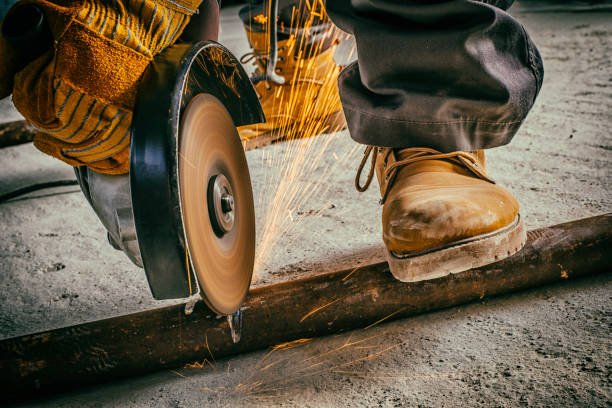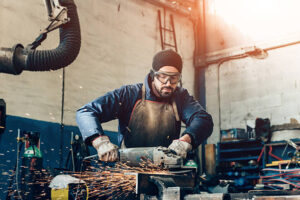Hand tools and power tools safety is important because all of them are widely used in our day-to-day activities as an essential part of our life. These tools reduce human efforts during different activities like construction, maintenance, erection, commissioning, services, etc. In old days, people did lots of hard work in their entire life due to the unavailability of technology, after that as time passes people developed some tools to reduce their efforts. First, they designed hand tools like hammers, chisels, wrenches, knives, etc., and then start using different energies to operate these tools (like electrical, pneumatic, etc.) to reduce effort and time. These energy-operated tools are known as power tools.
It is interesting to know that by using power tools people can save time, effort, and hard work but at the same time some risks are increased due to the use of energy for its operation. To avoid any accident during the use of hand tools and power tools it is required to understand the risk associated with hand tools and power tools.
Let’s understand Hand tools and power tools safety requirements in detail
Why Hand tools and power tools safety is important?
Data on accidents state that yearly over 960,000 injuries happened just because of power tools and thousands of people lost their lives due to accidents related to hand and power tools. As per CPSC injury with hand and power tools cost $ 15.4 million a year. All of these could be prevented by some basic awareness and precautions during using hand and power tools
Powered hand tools are the cause of many serious accidents on the job and account for various injuries.

Hazards of Hand tools and Power tools
- Noise: All power tools generate noise during their operation & if a person is continually exposed to noise levels of more than 85dBA their hearing capability is reduced
- Vibration: All portable tool generates vibration during their operation. In the case of the daily operation of vibrating tools, users may suffer from HAVS or white figure syndrome
- Electrical: Electrical power used to operate power tools in which risk of electrocution
- Fire (Heat): During the long use of tools, their bit heated and resulted in a fire. Some tools generate sparks (i.e. grinding machine)
- Ergonomics: Repetitive work may create an ergonomic hazard
- Fall (Slip & trip): Trip by cable or pneumatic hose used for the supply of electricity or air
- Mechanical: Due to continuous movement sometimes cutting tools got broken and resulted in serious injuries
- Radiation: Ultraviolet, visible lights generate in case of short-circuit in power tools
- Stuck against: During drilling sudden drill bit broke and the hand directly stuck against the wall
- Visibility: working in low lighting
- Secondary Hazard: Tool slipped while working (at height, floor, etc.) and injured someone working in its line of fire
Some common reasons behind injuries related to Hand tools and power tools :
- Unauthorized operation
- Overconfidence
- Using tools without safeguards (disk guard, bit guard, etc.)
- Unstable work surfaces or materials
- Using damaged tools
- Using the inadequate tool in an inadequate way
- Removing interlocks
- By passing the system (Deadman switch)
- Lack of attention (absence of mind)
- Tiredness due to long work by power tools (repetitive work)
- Joints in cable or using damaged cable
- Poor lifting techniques of tools
- Unsecured tools while working at a height
- Selection of wrong tools
- Use of tools without inspection
- Cables laid down on walkways
- Taking supplies without plug tops
- Using tools without having ELCB in its circuits
- Using tools after their sharpness is gone. As sharpness is gone person must put some force to drill, grind, or cut, and in that case risk of breakage of tools (drill bits, grinding disk, hacksaw blade, etc.) is maximized, which resulted in injuries
- Unexpected event
- Poor 5S at the working location
- Poor illumination
- Wok in a hurry
- Shortcuts
- Work without PPE (hand gloves, goggles, face shield, etc.)

Safety Controls to avoid accidents by using Portable hand tools and power tools
- Do not use any tool/equipment for which you are not trained to use
- Do not touch any new tools without knowing about their operation from any qualified instructor/supervisor/manufacturer’s instructions.
- Inspect all portable tools (hand or power) before use (outer case, power cord, blades/bits, etc.)
- Inspect all tools on monthly basis by a competent person through the checklist
- Never use damaged tools, if found any damaged tools during inspections put tags “OUT OF SERVICE” and inform to Supervisor
- Make sure portable tools (grinder, cutter, etc.) have appropriate guards
- Use power tools that are operated by a constant pressure switch (Deadman switch) so as a person leaves their hand from the switch machine stops
- The power cable of the equipment is in good condition
- Avoid joints in the cable
- Always use three prongs plug top for power tools
- Use double-insulated tools to avoid electrical shock
- Use 30ma ELCB or RCBO for protection against electrical shock
- Make sure all operating switches should be in good conditions
- Keep power tools cables away from heat, oil, chemical, or any sharp objects
- Never hold the power tool by its cable
- Never use portable tools rated for more than 240 V
- Use a power extension board equipped with ELCB
- Never keep your figure in the operating switch while plugin or plugging out power tools to avoid accidental operation
- Use the right tool for the right job
- Avoid working in a low-light area
- Replace tools immediately if you feel their sharpness gone
- Stop using power tools in wet environments
- Do not wear loose clothes while using power tools
- Don’t wear rings or jewelry or lose clothing while using tools
- Before adjusting, installing, and changing any accessory make sure it must be unplugged from the power socket
- Make sure your body posture is in good condition while using tools
- Always chose electrical tools according to the voltage rating
- Make sure all hand tools like chisels, wedges, or drift pins are free from mushroomed heads
- Always stores electrical power tools in dry places
- Where flammable atmospheres exist, spark-resistant tools (FLP) will prevent ignition
- Never use flammable chemicals (IPA, thinner, solvent-based cleaning agent, etc.) for cleaning power tools
- Never Use Plier as a hammer or chisel
- Do not modify the plier handle to gain more leverage
- While working on height make sure that the below area should be barricaded, and all tools must be secured to avoid falls from height
- Always use retractable knives for cutting
- Air supply hose must be in good condition and should be checked before connecting with pneumatic tools
- Check all air pipe connectors are locked properly to avoid sudden disconnection of the air pipe
- Use QRC or retainers’ devices in each power tool which is operated by pressurized air
- Provide an isolation valve to stop the air supply during any emergency
- Do not use compressed air for cleaning material, machine, or cloths
- Never point out pneumatic tools to anyone
- Always use googles, face shield, earplugs, helmet, hand gloves, and safety shoes according to work
Safety requirements while using Grinding machine
- Before mounting the abrasive wheel in the grinding machine, it should be inspected to ensure free from cracks/ defects.
- Ensure Disk design RPM is more than the machine RPM
- Ensure the Expiry date of the abrasive wheel before use
- The position of the guard must be toward your body, and it only allowed working parts to be exposed
- Do not fix the grinding wheel with different mounting arrangements or different size
- perform ring test to ensure the wheel is in good condition (it is not applicable for wheel dia less than 10 cm-4inch)
- Never remove the handle of the grinding machine
- Never use the sides of the wheel for grinding the surface
- Stop using the grinding machine if found more vibration
- Nameplate should be available on all machines to ensure its RPM and other details
- Inspect the location before starting work and see where the spark might fall to avoid fire
- Do not apply pressure on the disk while grinding or cutting
Safety requirements while using Drill Machine
- Use the appropriate drill bit according to the work
- Never use a metal drill bit for drilling in concrete or wood drill for metal to avoid the risk of bit break
- Replace the drill bit after its sharpness is gone to avoid injuries due to drill break
- Use hammering and normal function according to work in the drill machine
- Ensure that the machine is in good condition (including cable, body, switch, etc.)
- Always use goggles, face shield, earplugs, and hand gloves while using the drill machine
- Telescopic or portable guard must be used for bench drill
For videos related to safety follow us n Linkedin
for more toolbox talk click here…
To subscribe our newsletter share your mail id below
